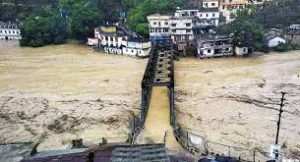Himachal Pradesh is highly vulnerable State to a large number of natural as well as man- made disasters. Earthquake and floods has jolted this hilly State many times and caused great losses to the State. Flood, cloudburst, landslide and cloud burst are other common natural calamities of the State.
Himachal Pradesh is located in the northwestern part of Himalaya. Himalaya came into being due to inter-continental collision between Indian Plate and Eurasian Plate. The inter-continental collision is causing volcanism, folding, faulting, under thrusting, uplift, crustal shortening and accumulation of seismic energy.
All the major rivers of the State have their sources in glaciers. One common feature of glacier area is the presence of glacier lakes. When these lakes burst causes flash floods. Sudden discharge of huge volume of water from glacial lake is known as Glacial Lake Outburst Floods (GLOFs).
Cloudbursts are associated with convective clouds. Vertical Development of clouds in Himalayan region is associated with its topography and southwestern monsoon wind direction. Vertical development of clouds can extend up to 15 kilometers above the earth surface. Sometimes a very heavy rainfall occurs of equal to or greater than 10 centimeters per hour which is called cloudbursts. Cloudbursts are usually associated with landslides and flash floods.
Sudden slide of large mass of snow along the slopes of mountain is called avalanche. They occur in high altitude area with steep valley slopes and are common in Kinnaur, Lahul and Spiti, Kullu, Chamba and Kangra districts.
[/lockercat]HPPCS Notes brings Prelims and Mains programs for HPPCS Prelims and HPPCS Mains Exam preparation. Various Programs initiated by HPPCS Notes are as follows:-- HPPCS Mains Tests and Notes Program 2025
- HPPCS Prelims Exam - Test Series and Notes Program 2025
- HPPCS Prelims and Mains Tests Series and Notes Program 2025
- HPPCS Detailed Complete Prelims Notes 2025
